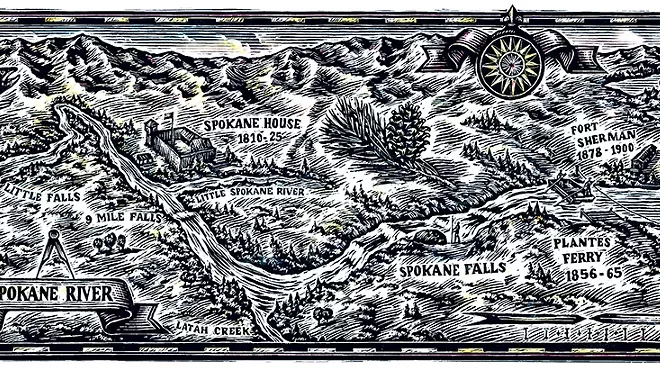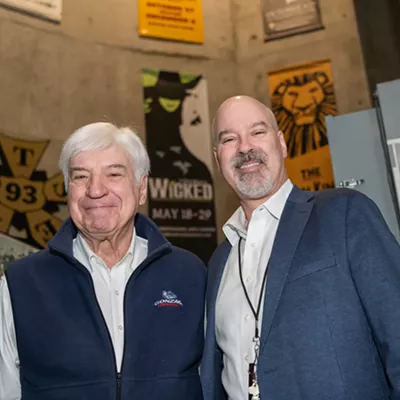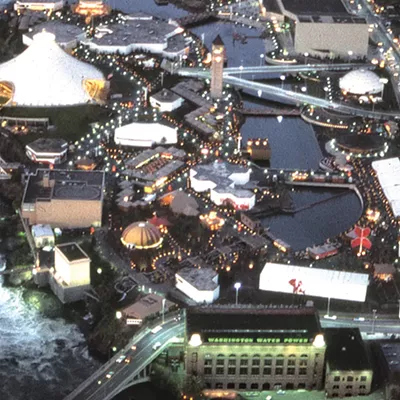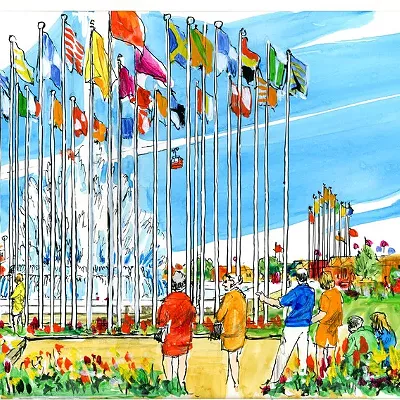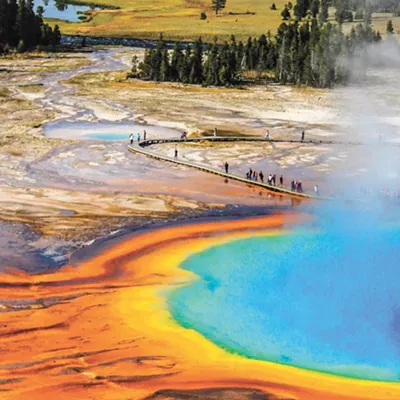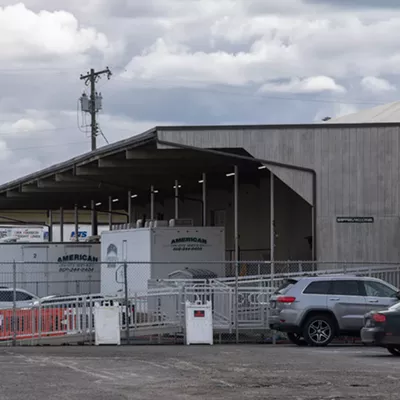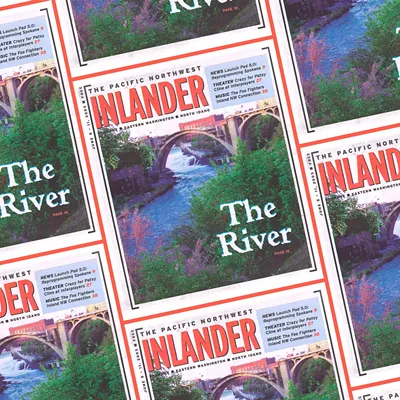We found the river, then we lost it, and now we are trying to recover it. That, in a sentence, is the history of human contact with Spokane Falls. Not many years ago, the river thundered through one of America's great wilderness settings. Abundant forests grew near its banks. Approaching on foot, Indians and early white trappers heard the sound of the falls long before they saw them.
Every year, thousands of salmon swam from the Pacific Ocean, up the Columbia River, and up the Spokane until they came to falls — and the awaiting Indians. Using spears and nets, native fishers caught hundreds of salmon daily, week after week. Standing at the base of the falls, amid the water and the fish, they were touched, even baptized by the river.
The Spokane Indians were so closely associated with the salmon that they imitated fish to indicate their tribal identity. As one early observer noted, by way of introduction the Indian hand "moved in a manner to suggest the movement of the tail of a salmon." The tribal name also suggests the intimate relationship between the Indians and the falls. Linguist Grant Smith argues that the best translation of Spokane is "Children of the Refracted Light" — from the Indian experience of standing in the river where the sun shown down through the spray of the falls.
When a white man came to Spokane with the intention of purchasing the land beside the falls as a town site, he too was baptized in the river. James Glover rode into Spokane on May 11, 1873, and bedded down for the night in a roofless squatter's cabin. Next morning, he rolled out of his blanket and walked to "a great rock" overlooking the falls. He later recalled: "I gave myself completely over to admiration and wonder at the beautiful, clear stream that was pouring into the kettle and over the falls." Glover was soaked by the spray, but didn't mind: "I sat there, unconscious of anything but the river, gazing and wondering and admiring."
If John Muir had ridden into Spokane in May 1873, the outcome might have been different. Muir was already encouraging Americans to preserve the natural wonders of the American wilderness, places like Yosemite, places that inspired "gazing and wondering and admiring." And Spokane Falls was one of those enchanted places.
Far-fetched?
Not at all.
Just consider what Carrie Adell Strahorn had to say on the subject. The wife of a Union Pacific employee, Strahorn traveled throughout the West and publicized her experience in a book called Fifteen Thousand Miles by Stage. In 1880, she and her husband arrived in Spokane. A few days earlier, they had been visiting Yellowstone, America's first national park. With one of the world's great natural wonders fresh in their experience, they might have thought little of Spokane Falls.
Instead, they were overwhelmed.
Carrie Strahorn wrote, "The virgin grandeur and beauty of the Spokane country appealed to us as no other place had done in all our travels. The little village of four hundred or five hundred people straggling over the park-like openings among the pines impressed us as one of the most picturesque in America."
James Glover had established by 1880 a store and a mill. The first settlers stayed close to the river in imagination and in reality. They named their town Spokane Falls, acknowledging the source of their identity and wealth. In homes and hotels in the village, you could hear the roar of the falls. For the first decade of its existence, the town of Spokane Falls attracted tourists from western Washington and Oregon to its sports fishery — "one of the finest on the coast" the Spokan Times declared.
But already Spokane was conquering its river — and in the process losing it. One mill was well and good, but why not two or four or more? Why not build them bigger and bigger?
Year by year, businessmen took control of the falls, rearranging the river to suit their needs. The riverbed was recontoured with dynamite and fill — here a picturesque rock was removed and there a channel was covered. Sawdust from the mills choked the life out of the trout, and sewage made the water — once used for drinking — unsafe even for swimming.
Electricity arrived, making the water power all the more valuable, and the utilitarian conquest of the river became all the more inevitable. Railroad bridges and highway bridges soon girdled the falls; parking lots, motels and railroad depots crowded the river banks. A huge iron trestle separated downtown Spokane from the river, and from its location on present-day Canada Island, an industrial laundry spewed dirty suds into the water.
Incredible as it may seem today, there was even talk during the 1950s of paving the southern channel of the river to provide more parking.
With the passage of time, Spokanites had all but forgotten the natural wonder in their midst. Their environmental amnesia is apparent today in our local place names. Riverside Avenue has always been a name but not a place — that is, not a place consistent with its name. The river is not even visible from the avenue, and never was.
More regretfully, the pioneers dropped a name that actually does belong to the town. The falls nurtured the city, but the city spurned the falls: in 1891, Spokane Falls became merely Spokane.
But then, who remembered the river anyway?
Sen. Warren Magnuson called the falls "Spokane's hidden treasure" and said "nobody ever knew the falls were here."
Fortunately, during the 1960s many Spokanites began to rediscover the falls and regretted that they were so hard to see and appreciate. In a series of events so complex and intriguing that describing them led this author to write the most lengthy book on any American world's fair since World War II, these citizens worked together to create Expo '74 — the environmental world's fair. Railroad bridges came down, along with depots, parking lots and the industrial laundry. They were replaced with exposition pavilions that, for the most part, were then replaced with a park.
Spokane's Expo was many things: a program of downtown renewal, a collection of international pavilions, an entertainment extravaganza. It was also one of the most successful world fairs in history in terms of its "residual" — the transformation of the locale where the fair took place. Expo '74 gave Spokane a park encompassing a beautiful river setting located right in the downtown core.
King Cole was the president of Spokane's exposition, but more than that he was the "heart" of the fair. Years later, he noted that previously the falls had been in a "very unattractive" part of town. "We got rid of that," he said, "and we supplanted it with something that was almost a fairy land in quality: A beautiful landscaped area, river banks, river full of fish, foot bridges everywhere, and lighting. So the whole thing was flipped over almost instaneously."
This was the triumph of Expo '74, but it was an incomplete triumph, and a few years later the process of forgetting the falls was on the verge of a tragic new phase.
Incredibly, there was the possibility for a time that a new bridge would be built over the falls. Seemingly the work of Expo '74 was about to be undone. The project would have been a dreary step backwards into the initial utilize-and-ignore phase of our relationship to the falls. Fortunately, the proposed Lincoln Street Bridge was finally abandoned.
But almost 30 years after the world's fair, the rediscovery of the falls is at best a job half done. The upper falls are easily accessible from Riverfront Park, but the lower falls remain — in Senator Magnuson's phrase — a "hidden treasure." No user-friendly pathway leads from the park to the lower falls.
Architect Rick Hastings would like to see this change. One of the founders of "Friends of the Falls," an organization dedicated to finishing the environmental job that Expo began, Hastings notes that while Spokane has a river environment unsurpassed by any other American city, other cities (such as San Antonio) surpass Spokane in connecting the community to the river.
The Friends of the Falls advocates a Gorge Park extending down the river from the upper falls — an idea first proposed by the Olmsted Brothers in 1908.
Other groups are promoting an Indian cultural center in a building overlooking the falls, and the extension of the Centennial Trail along the river beyond the falls.
Such activities indicate a growth in a sense of what Rick Hastings calls "loyalty and protectiveness" towards the falls. We may yet be able to "gaze and wonder" at the river, almost as James Glover did long ago.
When that day comes, Spokane will again be Spokane Falls. ♦



